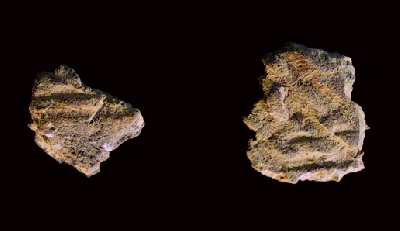August 7, 2002
Archaeological exploration of the vacant lot at 500 Prince Henry Ave., bounded by Bank and Pelham streets, was begun by the William & Mary Center for Archaeological Research (W&MCAR) on Monday, August 5. A crew of five persons will form the core of the field team. It is anticipated that work on this property will continue for at least two weeks.
The first step in the process started this week was establishment of a horizontal control grid across the property. Visible points on the grid were established at 10-meter intervals. A datum for elevation control was designated at the northeast corner of the lot. Using these controls a plan map of the project area was started showing primary landscape features and the locations of the initial tests.
By the end of the first day a few exploratory shovel tests had already probed deposits on the lot. These small, initial pits are a common and effective means of gauging what a project area has to offer and how best to conduct larger-scale excavations. By the end of the second day about 25 such tests had been opened across the property at a regular, 10-meter interval.
 By the time the last shovel test was excavated a good working sense of the archaeology had emerged. There is no portion of the property without artifacts of some sort. Artifact-bearing deposits average about 18 inches in depth. The darker, upper soil contains mainly historic period items dating as far back as the 18th century. The lighter-colored, lower deposit contains mainly prehistoric Indian artifacts dating as far back as 5000 years ago. Most of the artifacts date from the first half of the 20th century, reflecting the presence of active, modern dwellings either on or near the property. A considerable number of the artifacts, however, date from the mid-19th century, including the era of Civil War occupation. These include bottle glass, clothing buttons, food bone, and miscellaneous iron items. Some of the more interesting artifacts are a piece of Indian pottery from the time of earliest English contact, a pipe bowl fragment typical of the 18th century and perhaps associated with a nearby tavern, and numerous 19th-century buttons.
By the time the last shovel test was excavated a good working sense of the archaeology had emerged. There is no portion of the property without artifacts of some sort. Artifact-bearing deposits average about 18 inches in depth. The darker, upper soil contains mainly historic period items dating as far back as the 18th century. The lighter-colored, lower deposit contains mainly prehistoric Indian artifacts dating as far back as 5000 years ago. Most of the artifacts date from the first half of the 20th century, reflecting the presence of active, modern dwellings either on or near the property. A considerable number of the artifacts, however, date from the mid-19th century, including the era of Civil War occupation. These include bottle glass, clothing buttons, food bone, and miscellaneous iron items. Some of the more interesting artifacts are a piece of Indian pottery from the time of earliest English contact, a pipe bowl fragment typical of the 18th century and perhaps associated with a nearby tavern, and numerous 19th-century buttons.
In a couple of the shovel tests, indications of deeper “features” were encountered. Features are evidence of human activity observed as stains in the soil. Common types are cellars, wells, privies, etc. but the precise types represented in the study area are as yet undetermined.
This morning a new stage of the fieldwork will get underway – excavation of 1 x 1-meter "test units" in areas revealed by shovel tests to hold particular promise. At least six such units will be completed by the end of this week. These excavations serve to provide a representative sample of artifacts from different locations on the lot, and allow a better view of the deposits themselves. Upon completion of the test units heavy equipment will be employed to strip away selected areas of the topsoil, primarily to expose interesting features.
Last week members of our staff collected a range of historical maps and other records pertinent to the project area. The maps provide details of historical activity, mainly during the 19th and 20th centuries. Various records provide details as to the age and character of buildings that formerly stood on these lots or nearby. Most evidence indicates that a house on this property was constructed in 1840 as part of the early City Point "village". An adjacent lot was the site of a tavern as early as the 18th century.
In coming days, the project web site will be under construction. We look forward to visitation from city officials and planning of more public events.
 Skip to main content
Skip to main content
